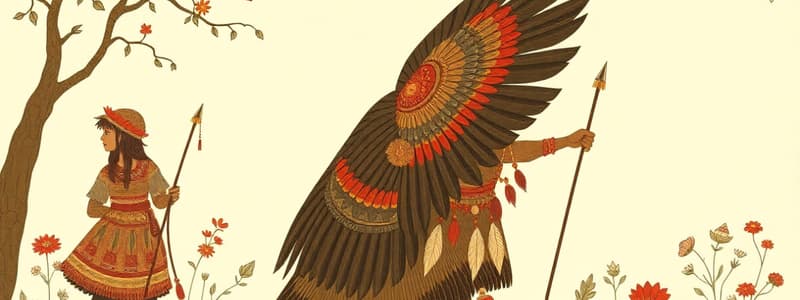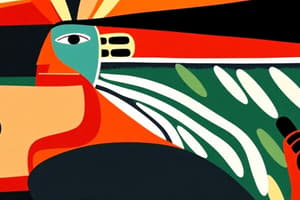Podcast
Questions and Answers
What role did clan mothers have within their clan?
What role did clan mothers have within their clan?
- They managed agricultural production exclusively.
- They represented the clan in external negotiations.
- They selected Council members and provided advice. (correct)
- They led military operations.
Who owned the longhouses within the Haudenosaunee society?
Who owned the longhouses within the Haudenosaunee society?
- The women, specifically the wives. (correct)
- The entire clan collectively.
- The men who built them.
- The clan leaders.
In Haudenosaunee families, who primarily took care of farming?
In Haudenosaunee families, who primarily took care of farming?
- Both men and women shared farming equally.
- Men primarily farmed while women took care of the home.
- Only children were responsible for farming activities.
- Women were responsible for farming and tending to crops. (correct)
What was one of the responsibilities of the men in the Haudenosaunee tribes?
What was one of the responsibilities of the men in the Haudenosaunee tribes?
What is a key characteristic of the family structure in Haudenosaunee society?
What is a key characteristic of the family structure in Haudenosaunee society?
What is true about the relationship between members of a clan in Haudenosaunee tribes?
What is true about the relationship between members of a clan in Haudenosaunee tribes?
Which statement accurately reflects the construction of longhouses by the Haudenosaunee?
Which statement accurately reflects the construction of longhouses by the Haudenosaunee?
How did the Haudenosaunee view marriage within their clans?
How did the Haudenosaunee view marriage within their clans?
What was the significance of longhouses to the Haudenosaunee?
What was the significance of longhouses to the Haudenosaunee?
What role did clan mothers have in Haudenosaunee society?
What role did clan mothers have in Haudenosaunee society?
Flashcards
Haudenosaunee Confederacy
Haudenosaunee Confederacy
A union of six Indigenous nations (Mohawk, Onondaga, Seneca, Oneida, Cayuga, and Tuscarora).
Six Nations
Six Nations
The name given to the Haudenosaunee Confederacy.
Longhouse
Longhouse
Large communal dwelling for many families within the Haudenosaunee culture.
Clan Mothers
Clan Mothers
Signup and view all the flashcards
Wampum
Wampum
Signup and view all the flashcards
Three Sisters
Three Sisters
Signup and view all the flashcards
Agricultural Tools
Agricultural Tools
Signup and view all the flashcards
Neutral stance in the American Revolution
Neutral stance in the American Revolution
Signup and view all the flashcards
Mutual Consent Marriage
Mutual Consent Marriage
Signup and view all the flashcards
Food Storage
Food Storage
Signup and view all the flashcards
Study Notes
The Haudenosaunee Confederacy
- The Haudenosaunee Confederacy, also known as the Six Nations, was a union of six Indigenous nations: Mohawk, Onondaga, Seneca, Oneida, Cayuga, and Tuscarora.
- The Haudenosaunee lived mostly in what is now upstate New York and southern Ontario.
The Haudenosaunee Nations
- The six nations were divided into two categories: "elder brothers" (Mohawk, Onondaga, and Seneca) and "younger brothers" (Oneida, Cayuga, and Tuscarora).
- The Haudenosaunee believed that all decisions within the confederacy required complete unanimity.
The American Revolution
- The Haudenosaunee tried to remain neutral during the American Revolution.
- Some Haudenosaunee villages fought on the side of the colonists, while others fought with the British.
Borrowed Ideas
- The early United States used the League of Nations as a model for their system of government.
- The League of Nations, which was organized by the Haudenosaunee, was a system of law and diplomacy to help maintain peace and cooperation among the nations.
Village Life
- The Haudenosaunee lived in villages based on the idea of cooperation.
- All members of the village shared food, even in times of hardship.
Clans and Families
- The Haudenosaunee tribes were divided into family groups called clans.
- Members of a family clan could not marry each other.
- A man joined his wife's clan when he married.
- Children belonged to their mother's clan.
- Clan mothers oversaw all aspects of clan life.
Sacred Trees
- The Haudenosaunee believed in respecting all of nature.
- The Haudenosaunee honored the forest by using only what they needed and avoiding waste.
- The Haudenosaunee used every part of trees to build their homes, cook, and craft tools.
Longhouses
- The Haudenosaunee built longhouses to live in.
- Longhouses could be more than 200 feet long and 25 feet high.
- Many families lived together in a single longhouse.
- Longhouses contained individual spaces for each family.
- The Haudenosaunee used every part of the trees to construct longhouses.
Marriage and Family Life
- The Haudenosaunee believed in mutual consent for marriage.
- The husband did not have authority over his wife.
- A wife could leave her husband if she desired to do so.
- Wives owned the longhouses and men moved into their wives' longhouses.
- Children belonged to their mother's clan.
- Men went out to hunt and farm.
- Women were in charge of the longhouses, gardened, raised children, and prepared food.
Clan Mothers
- Clan mothers had power within their clan.
- Clan mothers selected Council members.
- Clan mothers could dismiss council members if they made poor decisions.
Haudenosaunee Warriors
- Haudenosaunee men cleared fields and built and repaired longhouses.
- The men hunted, traded, and prepared for war.
- The men built weapons that included bows and arrows made of hickory or ash wood, blowguns and darts, and spears.
Haudenosaunee Battle Techniques
- The Haudenosaunee were skilled warriors known for their strategy and use of guerilla tactics.
- The Haudenosaunee learned to blend into the landscape and attack quickly.
- Colonist armies used the techniques they learned from the Haudenosaunee in their battles against the British.
Food
- The Haudenosaunee relied on agriculture for the majority of their food supply.
- The Haudenosaunee developed tools to help with farming, such as wooden rakes and spades.
- Haudenosaunee women owned the land and were responsible for farming.
- The Haudenosaunee grew corn, squash, beans, pumpkin, melon, and tobacco.
- The Haudenosaunee held annual festivals to give thanks to their gods for the harvest.
Three Sisters Succotash
- The Haudenosaunee mixed corn, beans, and squash together to make a dish called succotash.
Boiled Corn Bread
- The Haudenosaunee made corn flour by pounding corn kernels.
- The Haudenosaunee made cornbread by mixing corn flour with water and sometimes beans, berries, or nuts.
- The Haudenosaunee boiled the cornbread in a pot of water.
Wild Foods
- The Haudenosaunee foraged for nuts, fruits, vegetables, mushrooms, and eggs.
- The Haudenosaunee used sunflower oil to cook food, treat wounds, and protect their skin from the cold.
- The Haudenosaunee hunted wild game, such as bear, elk, deer, rabbit, wolf, turkey, duck, and birds.
- Men hunted turtles for their meat and shells.
- The Haudenosaunee shared all of their food with each other.
Storing Food
- The Haudenosaunee were very efficient about storing food.
- The Haudenosaunee dried and stored fish.
- The Haudenosaunee stored food on rafters in their longhouses.
- The Haudenosaunee stored food in buried clay pots lined with bark.
Clothing
- The Haudenosaunee wore animal skins in the form of leggings, shirts, moccasins, smocks, dresses, and skirts.
- The Haudenosaunee decorated their clothing with dyed porcupine quills.
- The Haudenosaunee women wore their hair long.
- The Haudenosaunee warriors wore their hair in a Mohawk (a single braid).
- The Haudenosaunee men and women decorated their bodies with tattoos.
Travel
- The Haudenosaunee traveled via canoe or on foot.
Wampum
- Wampum was important in Haudenosaunee culture:
- Wampum was a symbolic record of important information.
- Wampum represented a position of power and authority within the Haudenosaunee Confederacy.
- Wampum was used as a symbol of promise or agreement.
- Wampum was made using beads made of shells or beads.
- Shells or beads were dyed purple, cream, or both.
Celebrations and Festivals
- The Haudenosaunee celebrated many festivals and celebrations.
- One important festival was the Green Corn Festival, which was a celebration of the harvest.
Lacrosse
- Lacrosse was a popular Haudenosaunee sport and was often played in groups for competition.
Snow Snake Games
- The Haudenosaunee played snow snake games in winter after returning from hunting.
- The Haudenosaunee carved a "snake" out of wood.
- The Haudenosaunee dragged a log through the snow to create a path for teams to throw their snakes.
- The team that traveled the furthest distance won.
Studying That Suits You
Use AI to generate personalized quizzes and flashcards to suit your learning preferences.




